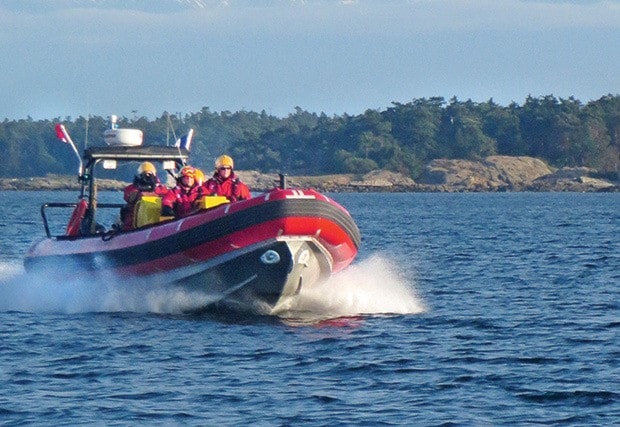Boating safety - RCM SAR Oak BayWith the early onset of summer weather, Oak Bay’s marine search and rescue has already been called out for those whose evening jaunt nearly turned tragic.
As pleasure craft multiply over weekends leading up to summer, RCM-SAR Station 33 Oak Bay offers safety checks both ahead of time and on the water.
“We come alongside a boat and ask them if they want to have a pleasure craft safety check. Some people really like an incentive so what we’ve done the last couple of years is hand out these safety kits,” said training officer Nathan Leung.
Their inexpensive offering is a bailing bucket containing a mirror, line, flashlight and whistle, among the required gear for boating.
“We spend 10 minutes with them and go through a variety of things,” Leung said, including required items such as the obvious – a personal floatation device for each person on board.
“People don’t like to wear them because they don’t look very cool but it’s like jumping out of a plane with your parachute off and trying to put it back on,” Leung said.
Something to bail with, navigation lights and 15 metres of heaving line are all required on small pleasure craft.
“We go through all the mandatory safety equipment,” Leung said. “Then we go through optional equipment, some of the optional equipment is the most important. I think everyone should have a VHF radio.”
Kim Bentzon, deputy station manager, heartily agrees. The training required to use the radio on a regular basis for communication, doesn’t matter in an emergent situation. Some rescue calls over the radio are literally “hello, hello, hello, help,” he said.
“If you’re in trouble and you have this [waterproof VHF radio] on board and you don’t know how to use it, they don’t care,” Leung said, noting cellphones don’t work after a good dunking.
Something as simple as filing a sailing plan can cut the time and effort needed to affect a rescue.
Betzon recalls going out to find an experienced mariner off of Oak Bay after he lost a poorly lashed grab bag that included his VHF radio. Because of his experience, the kayaker filed a sailing plan with his wife and the boat rental company stating where he was headed, and when he’d return. They were able to alert the police who sent out the SAR team.
Perhaps one of the simplest, and most missed, safety tool is simply to check the weather before you go.
“Oak Bay is a very tumultuous area for water movement, which is at times deceiving,” Leung said.
What appear to be calm waters from shore can be much different further out. Less experienced boaters should ask someone with more experience about areas to avoid. At the least know your navigational aids – they mark hazards or safe transit.
“It is important for new boaters to study a marine chart of the area that they will be boating in and identify what the navigational aids are marking,” Leung said.
Leung and Betzon are among the 45 volunteers who crew the local Royal Canadian Marine Search and Rescue team.
“Some people can only give two to three years and then they have to move on,” said Terry Calveley, Oak Bay Sea Rescue Society president. The society funds what some still call the ‘Oak Bay Navy’.
The crew welcome questions on safety, weather or how to volunteer on their Facebook page facebook.com/RCMSAR33.
Learn more about the society at obsr.ca or marine search and rescue in general at rcmsar.com.
cvanreeuwyk@oakbaynews.com
